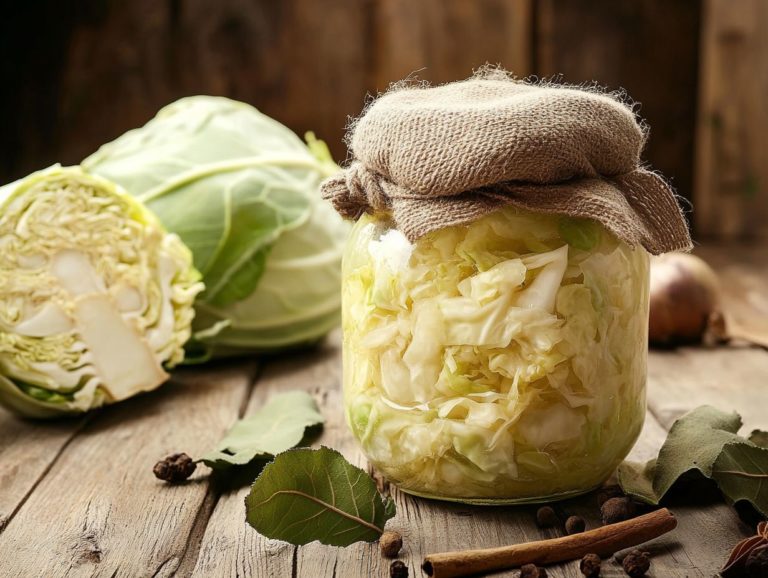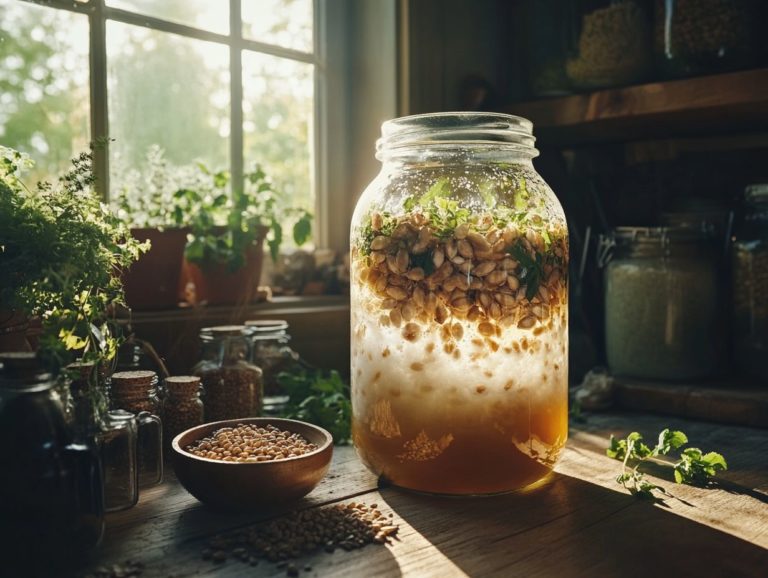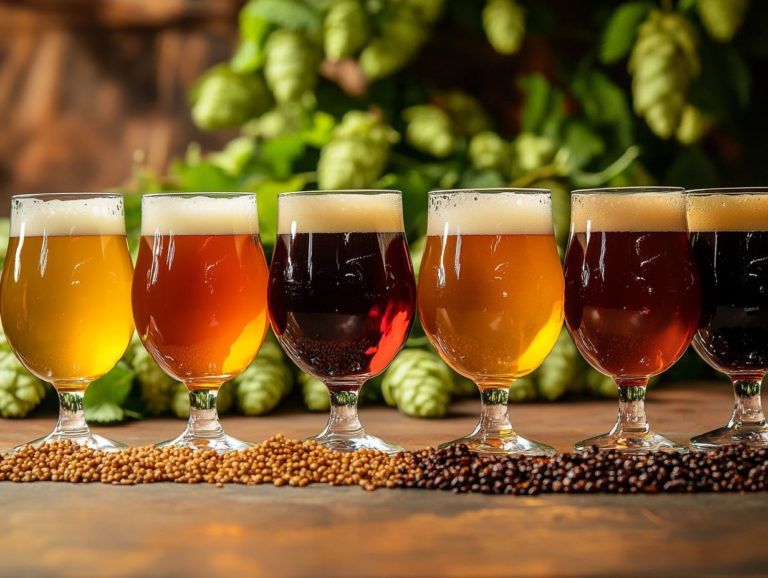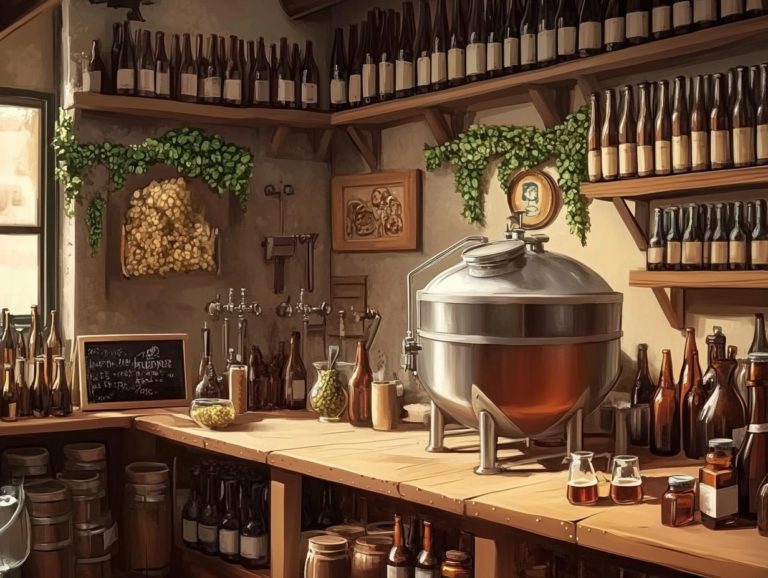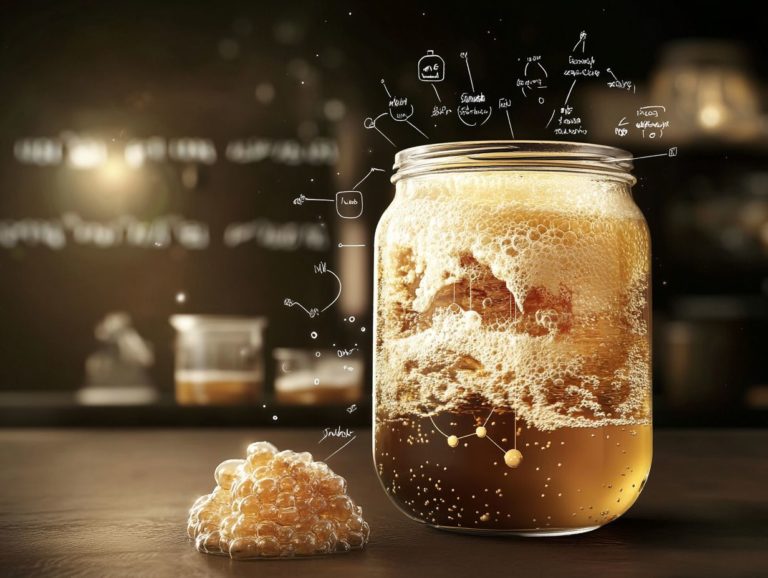Fermentation and Its Effect on Beer Shelf Life
Fermentation is a remarkable biochemistry process that transforms simple ingredients into a flavorful beverage, forming the very cornerstone of beer-making.
By understanding how fermentation operates, its various roles in brewing, the brewing process, and the key ingredients involved, you can significantly enhance your appreciation for this ancient craft. Fermentation not only influences taste but also plays a crucial role in determining a beer’s shelf life.
This article delves into the science behind fermentation, examining the factors that influence beer longevity, including contamination risks, and offering tips for extending freshness, ensuring that you enjoy every sip with complete peace of mind.
Contents
- Key Takeaways:
- The Magic of Fermentation!
- What is the Role of Fermentation in Beer Making?
- What Are the Different Types of Fermentation Used in Beer Making?
- What Are the Key Ingredients for Fermentation in Beer Making?
- What Factors Affect Beer Shelf Life?
- How Does Fermentation Affect Beer Shelf Life?
- What Other Factors Can Impact Beer Shelf Life?
- How Can You Extend the Shelf Life of Beer?
- What are the Signs of Spoiled Beer?
- How Can You Prevent Spoilage in Beer?
- Frequently Asked Questions
- What is fermentation and how does it affect beer shelf life?
- What are some factors that can impact the fermentation process and beer shelf life?
- How does the type of yeast used in fermentation impact beer shelf life?
- Can temperature affect beer shelf life during fermentation?
- What is the role of oxygen in fermentation and beer shelf life?
- Do preservatives impact the fermentation process and beer shelf life?
Key Takeaways:
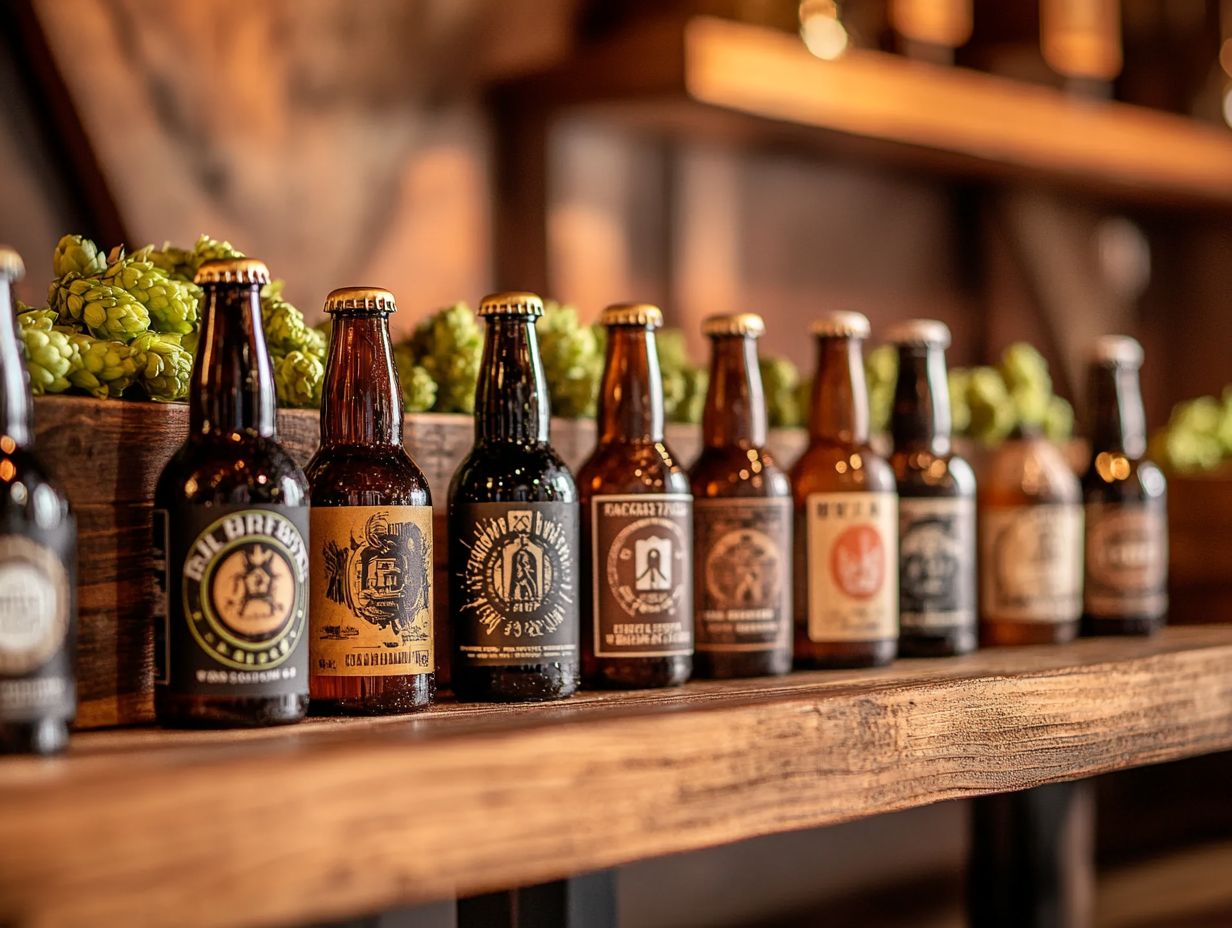
- Fermentation is a natural process in beer-making where sugars are converted into alcohol and carbon dioxide, giving beer its distinctive flavor and character. This process involves various microbes including yeast and bacteria.
- The type and quality of fermentation, along with proper storage and handling, greatly affect the shelf life of beer. Improper fermentation can lead to off-flavors and spoilage.
- To extend the shelf life of beer, pay attention to fermentation techniques and proper storage and handling. Signs of spoiled beer include off-flavors, cloudiness, unclean beer lines, and an unpleasant odor.
The Magic of Fermentation!
Fermentation is an essential biochemical process in which sugars are transformed into gases, acids, or alcohol through the action of microorganisms like yeast and bacteria. This intricate process lies at the heart of brewing, particularly in beer production, where specific yeast strains, such as Saccharomyces cerevisiae and Saccharomyces pastorianus, are pivotal in converting wort (the liquid extracted from malted grains used in brewing) into alcohol. Modern brewing techniques also explore genetic engineering to optimize these processes.
These strains contribute to the distinctive flavor profiles and aromas that characterize different types of beer. As a brewer, grasping the nuances of fermentation is crucial. This knowledge enables you to control the quality and characteristics of your final product, ensuring optimal alcohol production and enhancing flavor to delight the palate. Quality control practices are essential in this context.
How Does Fermentation Work?
Fermentation is a fascinating process where yeast and other microbes work diligently to break down sugars found in the wort, primarily derived from grains like barley, to produce not just alcohol but also carbon dioxide and an array of flavor compounds. Fresh wort quality is crucial in this process.
As this transformation unfolds, yeast cells eagerly consume the sugars and convert them into alcohol in a process known as alcoholic fermentation, with carbon dioxide being released as a natural by-product. This journey begins when you pitch the yeast into the wort, activating it under optimal temperature conditions. Maintaining a delicate balance of microbial activity ensures a healthy fermentation environment.
However, you must tread carefully; unwanted bacterial contamination can sneak in, leading to off-flavors and undesirable aromas in your final product. This reality highlights the importance of maintaining a clean and controlled fermentation setting, which ultimately enhances the quality of your brew.
What is the Role of Fermentation in Beer Making?
Fermentation is a crucial stage in the art of beer making. Here, yeast takes center stage, transforming the sugars extracted during the mashing process into alcohol and carbon dioxide. This magical transformation doesn’t just create the fundamental components of beer; it also develops the unique flavors and aromas that define various styles, from crisp lagers to rich ales. Proper hygiene practices are essential to ensure this process is successful.
Embrace this extraordinary process, as it is where the true character of your brew begins to emerge.
Have you ever wondered how your favorite beer gets its unique taste? Explore the fascinating world of fermentation and try brewing your own beer at home to experience the magic firsthand!
What Are the Different Types of Fermentation Used in Beer Making?
In the world of beer making, you primarily encounter two types of fermentation: top fermentation and bottom fermentation. Each method uses different yeast strains Saccharomyces cerevisiae for ales and Saccharomyces pastorianus for lagers. These strains give different flavors and qualities to the beer and are part of a long brewing history.
These yeast strains play crucial roles in the brewing process. They influence not only the alcohol content but also the flavor profiles, which can range from fruity and floral to clean and crisp. Ales, typically brewed at warmer temperatures, tend to feature a fuller body and bolder flavors. This is thanks to the active production of esters and phenols by the top-fermenting yeasts. On the other hand, the cooler fermentation temperatures associated with lagers yield a more subdued and smooth taste.
While yeast undoubtedly takes the spotlight in fermentation, certain sour beers bring bacteria into the mix, such as Lactobacillus and Pediococcus. These little contributors introduce lactic acid, developing tangy flavors and expanding the range of styles available for your enjoyment. Other microbes like Brettanomyces, Zymomonas, Acetobacter, and Gluconacetobacter can also play a role.
What Are the Key Ingredients for Fermentation in Beer Making?
The essential ingredients for fermentation in beer making include malted barley, which provides the wort, various yeast strains that drive the fermentation process, and sources of amino nitrogen that promote yeast growth and activity. Enzymes and amino acids are also crucial for this process.
Malted barley is the foundational building block, supplying the necessary sugars for fermentation. The different yeast varieties, chosen for their distinct flavor profiles, work their magic by converting these sugars into alcohol and carbon dioxide. Enzymes naturally found in malt play a critical role. They break down complex carbohydrates into fermentable sugars, ensuring a smooth fermentation process. This interaction not only dictates the alcohol content but also profoundly influences the beer’s mouthfeel and flavor complexity.
The malting process is essential to prepare the barley for this enzymatic activity. Grasping these components and their intricate interplay is vital for you as a brewer who aims to craft a balanced and delightful beer.
What Factors Affect Beer Shelf Life?
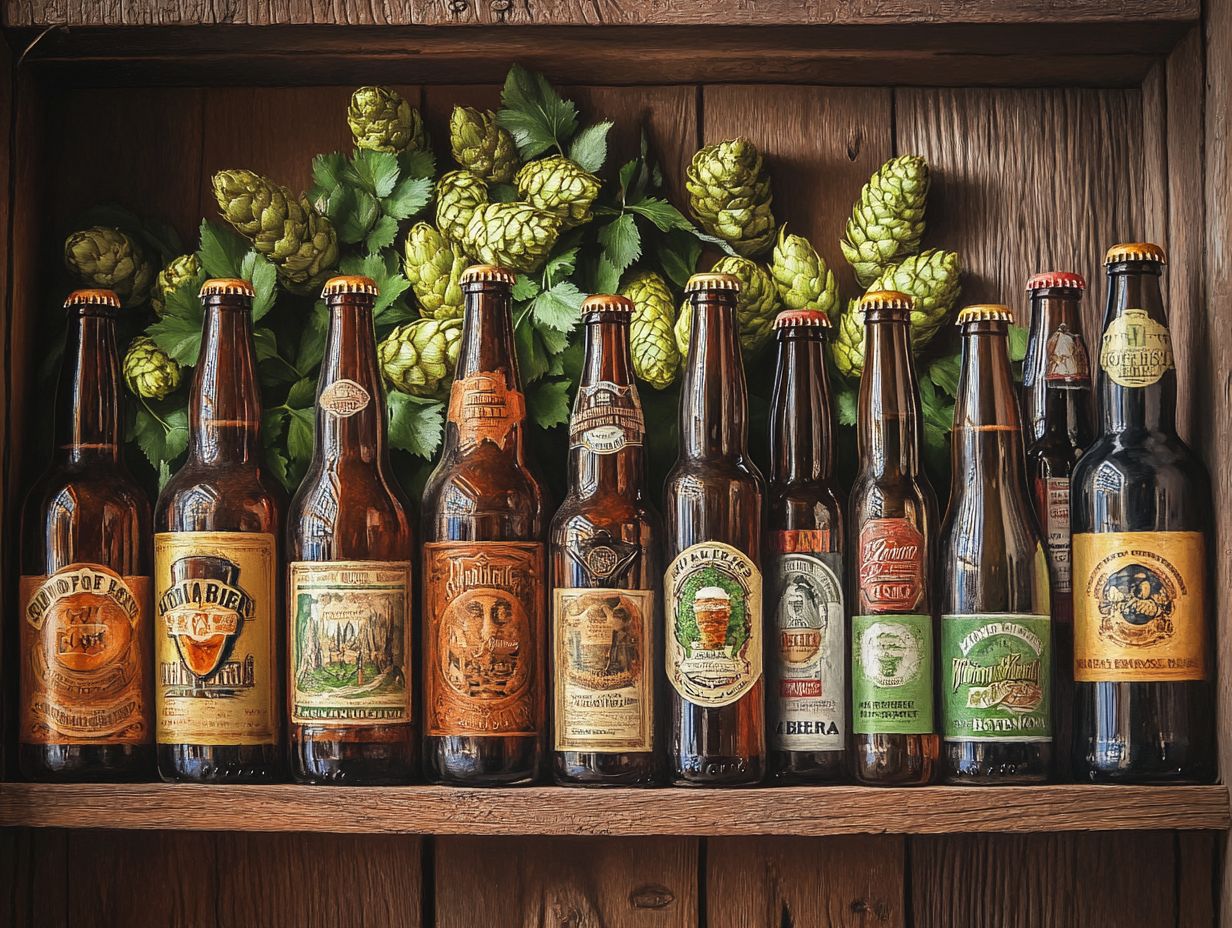
Several factors can greatly influence the shelf life of your beer. These include the quality of fermentation, the conditions in which it’s stored, and the potential presence of contaminants like bacteria. A comprehensive quality report can help in monitoring these factors.
Such contaminants can introduce off-flavors and spoilage, making it essential for you to maintain stringent hygiene practices throughout the brewing process.
How Does Fermentation Affect Beer Shelf Life?
Fermentation plays a crucial role in determining the shelf life of your beer, as it directly influences microbial balance and flavor stability. If your fermentation process is incomplete or poorly managed, you risk developing off-flavors or spoilage that can compromise the quality of your brew.
Ensuring proper yeast health is vital. A vigorous fermentation process not only breaks down unwanted compounds but also provides natural preservation. When your yeast is strong and healthy, it effectively outcompetes any potential brewing bacteria that could lead to contamination or spoilage. Therefore, keeping brewing yeast in optimal condition is crucial.
By carefully managing fermentation temperature and duration, you create the ideal environment for the desired flavors to flourish while suppressing the growth of unwanted microorganisms. Consistent brewing techniques help maintain this balance.
This delicate balance can significantly enhance the longevity of your beer’s flavors, preventing those undesirable characteristics that often arise from improper fermentation practices.
Now that you know the importance of fermentation, why not try adjusting your brewing process and see how it affects your beer?
What Other Factors Can Impact Beer Shelf Life?
Along with fermentation, factors such as storage conditions, exposure to light, temperature variations, and sanitation practices are crucial in determining the shelf life of beer. These elements significantly influence how well the beer retains its intended flavors and aromas.
Environmental conditions are key; a dark, cool space can work wonders in prolonging a beer s freshness, while heat and UV light can hasten its decline. You should also be mindful of handling procedures excessive shaking or jolting can disturb the beer s delicate balance, leading to unwanted changes in taste and carbonation.
Proper storage methods, like using airtight containers and maintaining stable temperatures, are essential for preserving quality. The brewing industry often emphasizes these factors in their quality control guidelines.
Maintaining cleanliness throughout the brewing and bottling process is vital to prevent contamination, which can destabilize flavors and shorten shelf life. Paying attention to these details means you can enjoy your favorite brews for much longer!
How Can You Extend the Shelf Life of Beer?
To extend the shelf life of beer, you can implement a range of effective strategies. This includes employing specific brewing techniques that enhance preservation, maintaining optimal storage conditions that prevent spoilage, and adhering to rigorous sanitation and quality control practices throughout the production process. Avoiding contamination risks is also crucial.
These measures will not only improve the longevity of your beer but also ensure its quality and flavor remain exceptional.
What Brewing Techniques Can Improve Beer Shelf Life?
Some brewing methods can greatly improve the shelf life of your beer. By optimizing fermentation processes, ensuring meticulous sanitation, and employing yeast management practices the careful control and monitoring of yeast during brewing that foster consistent and healthy fermentation, you’re setting yourself up for success.
When you focus on fermentation optimization, you enhance the stability and flavor profile of your beers while extending their longevity. Implementing stringent sanitation protocols is essential to ward off any microbial contamination, allowing only the desired yeast strains to flourish.
Effective yeast management strategies, such as regular monitoring and nutrient supplementation, help maintain a healthy microbial balance, leading to a robust fermentation process. These quality control measures not only protect the integrity of your final product but also elevate the overall drinking experience. Therefore, it’s crucial to prioritize these techniques in your brewing operations.
How Can Proper Storage and Handling Prolong Beer Shelf Life?
Proper storage and handling of beer are essential for extending its shelf life. By maintaining stable temperatures, minimizing light exposure, and implementing stringent sanitation practices, you can significantly enhance the quality and longevity of your beer.
To preserve the intended flavors and aromas of your favorite brews, it s crucial to keep them at a consistent temperature, ideally between 45 F and 55 F for most styles. Any fluctuations can lead to undesirable changes that may compromise the taste you love.
Minimizing direct light exposure is also key since ultraviolet rays can create skunky off-flavors, especially in lighter beers. Investing in dark or opaque storage solutions will protect your beer from this potential harm.
Cleanliness should never be an afterthought. Ensuring that all containers and taps are thoroughly sanitized helps prevent contamination that could spoil even the highest quality brews.
By following these best practices, you can savor your favorite beverages at their absolute finest.
What are the Signs of Spoiled Beer?
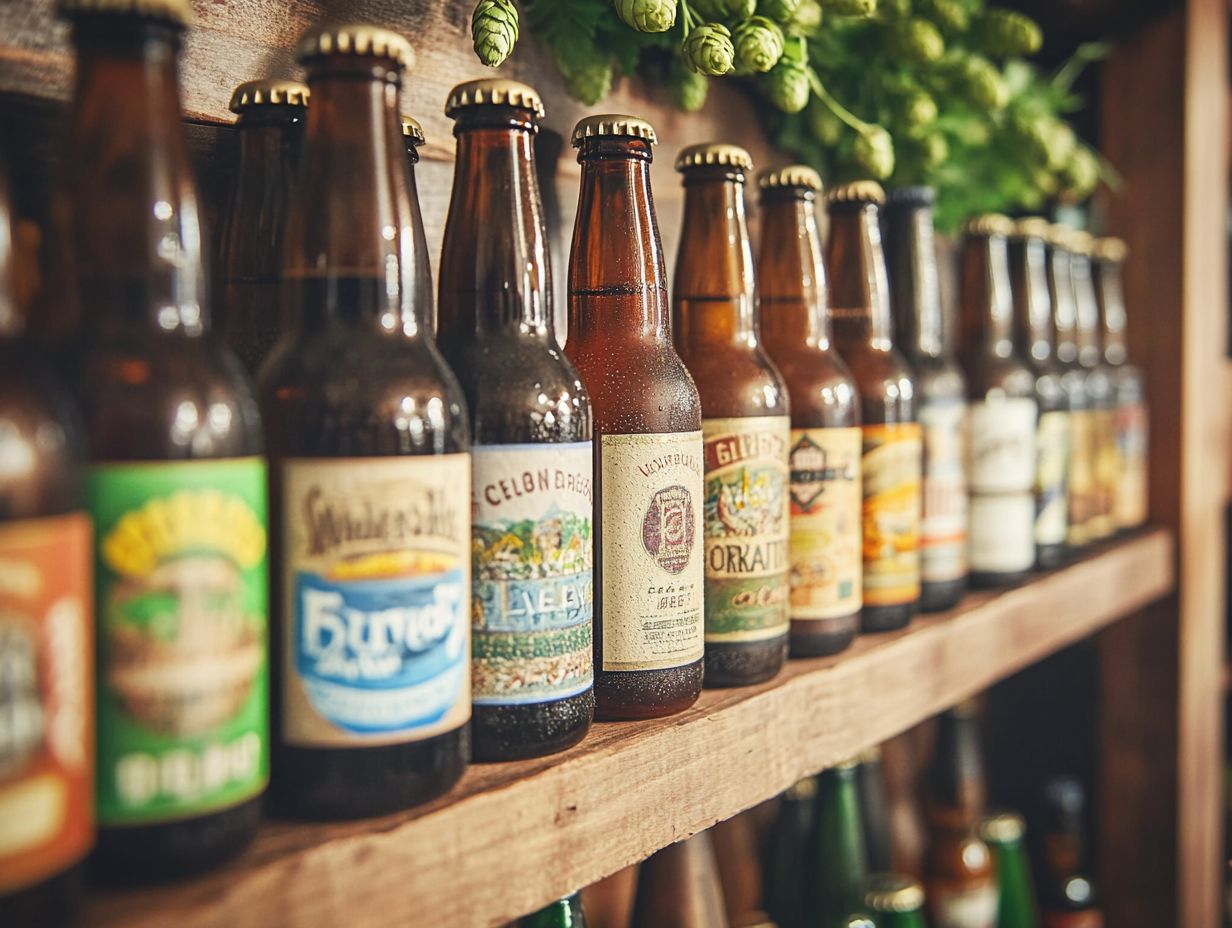
Recognizing the signs of spoiled beer is crucial for both consumers and brewers. Key indicators to watch for include off-flavors, such as an unexpected sourness or peculiar odors.
These abnormalities often arise from contamination or improper fermentation processes, highlighting the importance of vigilance in maintaining quality.
Consider applying these tips to your brewing and storage practices, and feel free to share your experiences with beer storage!
How Can You Tell if a Beer Has Gone Bad?
To determine if a beer has gone bad, you should look for specific signs like unusual aromas, sour or off-flavors, and sedimentation that may indicate spoilage or less-than-ideal brewing practices.
These sensory indicators often reveal underlying issues that can stem not only from the ingredients themselves but also from how the beer has been handled throughout the brewing and storage process. A distinct skunky smell might suggest exposure to light.
Additionally, an overly yeasty aroma could signal fermentation that hasn t gone as planned. Visual inspection is equally important; a hazy appearance or excessive bubbles can point to unwanted microbes or carbonation problems.
Understanding these nuances highlights the brewery’s commitment to quality control, ensuring that every batch maintains its intended flavor profile and freshness.
What Are the Risks of Drinking Spoiled Beer?
Drinking spoiled beer can pose significant health risks, including gastrointestinal issues and exposure to harmful bacteria. Stay alert about the quality of your beer!
These health concerns often arise when the brewing process is compromised, leading to off-flavors that signal mishaps in fermentation or storage. Missteps like improper sanitation or neglecting temperature controls can allow unwanted microorganisms to flourish.
This can turn what should be a refreshing beverage into a source of illness. Quality control is paramount in the brewing industry. Without stringent measures in place, both brewers and consumers risk their health without even realizing it.
Therefore, staying informed about beer quality not only elevates your tasting experience but also protects your well-being.
How Can You Prevent Spoilage in Beer?
Preventing spoilage in beer requires a simple plan that encompasses rigorous sanitation practices, meticulous monitoring of the fermentation process, and the implementation of stringent quality control measures.
By focusing on these aspects, you can effectively minimize bacterial contamination and uphold the integrity of your product. This ensures that every sip remains as delightful as intended.
What Are the Best Practices for Storing and Serving Beer?
To elevate your beer experience, focus on best practices for storing and serving that brew. Start by maintaining precise temperature control, keeping your beer away from light, and ensuring your serving equipment is scrupulously clean.
These elements are vital for preserving the unique flavors and aromas that each beer has to offer. For instance, storing your ales at a consistent temperature between 45 F to 55 F is ideal, while lagers prefer a slightly cooler environment.
This careful temperature management prevents any degradation of taste. Be mindful of UV exposure, as it can impart those undesirable skunky flavors; opt for dark or tinted glass containers to protect your precious beer.
Don t underestimate the importance of sanitation using impeccably cleaned glasses and taps is essential for avoiding contamination that could spoil the beer and detract from its intended experience.
By adopting these practices, you ll ensure that every sip is a delight and that the integrity of your beverage remains intact.
What Are the Common Mistakes That Can Lead to Beer Spoilage?
Common mistakes that can lead to beer spoilage include inadequate sanitation during brewing, improper fermentation management, and failure to control storage conditions. All of these can compromise your beer’s quality and result in off-flavors.
For instance, if you neglect to thoroughly sanitize your equipment, you risk introducing unwanted bacteria or wild yeast, which can drastically alter the flavor profile you aimed for. Similarly, if you mismanage fermentation temperatures, you may end up with esters and phenols that overwhelm the beer s intended characteristics.
Improper storage practices like exposing your beer to fluctuating temperatures or prolonged light exposure can accelerate degradation. This transforms those once-pleasant aromas and flavors into something stale or skunky.
Both brewers and consumers need to be vigilant and informed. A diligent focus on these details is essential for savoring a consistently high-quality beer experience.
Frequently Asked Questions
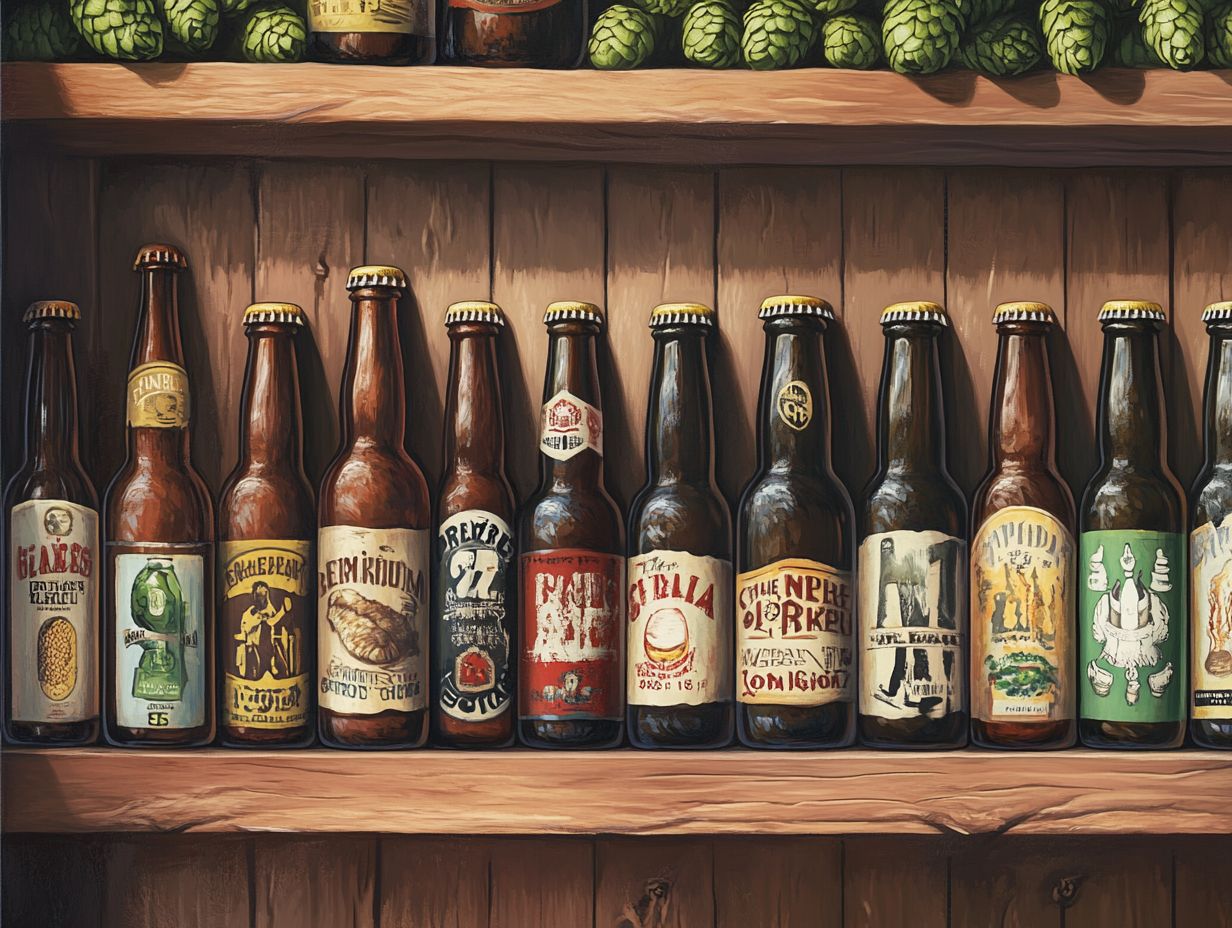
What is fermentation and how does it affect beer shelf life?
Fermentation is the process in which yeast converts sugars into alcohol and carbon dioxide, resulting in beer. The yeast also produces substances that change the beer’s taste and aroma. These substances can either extend or shorten the beer’s shelf life, depending on their concentration and type.
What are some factors that can impact the fermentation process and beer shelf life?
The type and amount of yeast used, temperature, oxygen exposure, and the composition of wort the mixture of water, malt, and hops can all affect fermentation and ultimately the beer’s shelf life. Other influencing factors include sanitation, storage conditions, and the use of preservatives.
How does the type of yeast used in fermentation impact beer shelf life?
The type of yeast used directly influences the beer’s flavor, aroma, and shelf life. Different strains of yeast produce various compounds, such as esters and phenols, which can enhance or reduce the beer’s shelf life. For example, ale yeast is known for producing fruity esters, while lager yeast produces fewer esters and more sulfur compounds, resulting in a longer shelf life.
Can temperature affect beer shelf life during fermentation?
Temperature plays a crucial role in brewing! It can make or break your beer’s quality. Yeast is highly sensitive to temperature; if it s too low, fermentation may slow down or stop, leading to a shorter shelf life. Conversely, if the temperature is too high, it can produce off-flavors and shorten the beer’s shelf life.
What is the role of oxygen in fermentation and beer shelf life?
While oxygen is essential for yeast growth during fermentation, excessive exposure can negatively affect shelf life. Oxygen can cause oxidation, leading to undesirable off-flavors. Brewers carefully control oxygen exposure during fermentation to ensure the best possible shelf life for their beer.
Do preservatives impact the fermentation process and beer shelf life?
Yes, preservatives such as sulfites or sorbates can affect the fermentation process and beer shelf life. These additives can inhibit yeast growth, resulting in reduced fermentation and a shorter shelf life. It s important for brewers to carefully consider the use of preservatives and their potential impact on beer quality.

